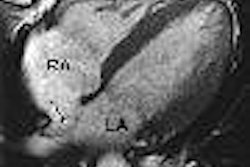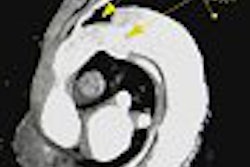SAN FRANCISCO - Using dobutamine stress MRI (DSMR) to detect myocardial ischemia in coronary artery disease is hardly a new-fangled technique. But is the technique of any value for forecasting whether these patients will suffer from major adverse cardiac events? Yes, according to a presentation Friday at the Society for Cardiovascular Magnetic Resonance (SCMR) meeting.
"DSMR is well-established in clinical, routine diagnostics for detecting myocardial ischemia," said cardiologist Dr. Oliver Bruder from Elisabeth Hospital in Essen, Germany, adding that DSMR does not require a sufficient acoustic window, unlike dobutamine stress echocardiography. "But little is known about the prognostic implications of (the DSMR) method."
Bruder's study co-authors include radiologists Dr. Peter Hunold and Dr. Jörg Barkhausen from the University Hospital, also in Essen.
For this study the group used high-dose DSMR in 384 patients, all with clinically suspected coronary artery disease. Imaging exams were performed on a 1.5-tesla system (Magnetom Sonata, Siemens Medical Solutions, Erlangen, Germany) with a fiber-optic ECG system.
A segmented, steady-state, true-FISP sequence was used. A dobutamine/atropine stress protocol was used until 85% of the age-predicted heart rate was achieved. The infusion rate was 10, 20, 30, and 40 μg/kg/min of dobutamine and up to 1 mg of atropine. Three continuous long- and short-axis views were obtained at rest and at maximum stress, Bruder said.
"Myocardial ischemia was defined by new or worsening wall-motion abnormalities under stress in more than one myocardial segment," the authors wrote in their SCMR abstract. A radiologist and cardiologist performed a consensus reading, Bruder explained.
Clinical follow-up was performed for at least 12 months to determine the occurrence of any major adverse cardiac events, such as myocardial infarction, unstable angina, and cardiac death.
"The focus was on the patients who were not being revascularized," Bruder said.
According to the results, 153 patients underwent coronary catheter angiography, and DSMR yielded an 86% sensitivity and 88% specificity for coronary artery stenosis (> 70%). Of these 153, 64 had to be excluded as they were scheduled for immediate revascularization.
In the remaining 320 patients, 49 had wall abnormalities seen with DSMR. Of these 49, 24.5% had major adverse cardiac events during the follow-up period. Of the 271 patients without wall-motion abnormalities, only 8.5% experienced major adverse events.
High-dose DSMR is a robust and accurate diagnostic test for assessing myocardial ischemia, as well as predicting major cardiac events, the group concluded.
Session co-moderator Dr. Juerg Schwitter suggested that the 8.5% rate of major adverse events in wall-motion negative patients was not entirely insignificant. Bruder explained that this figure might reflect a bias in their patient population.
"Our center is an interventional center and MR center as well," he said. "We get a lot of patients with severe coronary artery disease. This was part of the clinical routine workup."
A session attendee asked if the group planned to reanalyze the results, looking at only one segment versus two adjacent segments. Bruder said that since this preliminary study was submitted to the SCMR, the group has collected data on 800 patients and is currently performing more analysis.
These results correlate with research published in late 2004 in European Radiology. Investigators from the Netherlands found that patients with a negative DSMR study but with wall-motion abnormalities had a significantly higher annual major adverse cardiac events rate (18% of the 214 patients). They calculated a positive predictive value of 95% and a negative predictive value of 93% for DSMR in these patients (European Radiology, November 2004, Vol. 14:11, pp. 2046-2052).
By Shalmali Pal
AuntMinnie.com staff writer
January 24, 2005
Related Reading
Myocardial echocardiography aids chest pain evaluation, December 24, 2004
Myocardial ischemia, viability made apparent with MR, February 6, 2004
PET may overpredict myocardial recovery compared with MRI, March 11, 2003
Copyright © 2005 AuntMinnie.com



.fFmgij6Hin.png?auto=compress%2Cformat&fit=crop&h=100&q=70&w=100)




.fFmgij6Hin.png?auto=compress%2Cformat&fit=crop&h=167&q=70&w=250)











